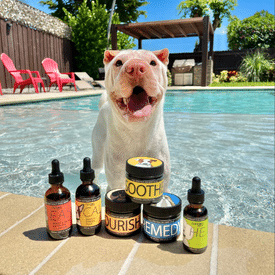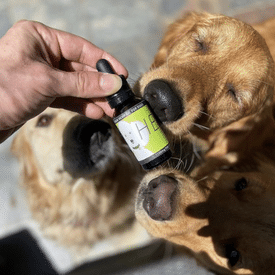Cannabis and CBD Terms Explained

As more folks turn to Cannabis and CBD for their pets, you might come across some new vocabulary terms. From cannabinoids to terpenes, full spectrum to isolate, here are a few words to help you understand the world of CBD for pets. From cannabinoids to terpenes, and the difference between full spectrum and isolate—these are all integral parts of the CBD world. So, let’s break down some of these terms to make your journey into the realm of CBD for pets a bit more comprehensible.
Table of Contents
2-AG (2-Arachidonoylglycerol)
2-AG is a signaling chemica present at high levels in the central nervous system and has been identified within breastmilk in humans. 2-Arachidonoylglycerol (2-AG) was the second endocannabinoid to be identified when it was isolated from within a rat’s brain and the gut of a canine.
Anandamide
AEA is known as the ‘bliss’ or ‘joy’ molecule. Anandamide is structurally very similar to the cannabinoid, 9-Tetrahydrocannabinol (THC). This compound is particularly important because it was the first endocannabinoid to be discovered from the pig brain by William Devane and his team of researchers in 1992.
Bioavailability
Bioavailability refers to the amount of time, and at what rate, something is absorbed into your bloodstream and how much is excreted without effect. This is important because bioavailability effects how much to give in one dose, and how quickly your pet can feel the effects.
Broad Spectrum
Broad-spectrum is a term used to refer to extracts in which one or more compounds, such as THC have been removed from a whole plant extract.This process can negate the entourage effect. You might see this more with CBD from marijuana plants with higher than .3 percent THC, rather than CBD from hemp oil.
Cannabidiol (CBD)
Cannabidiol, or CBD, is the primary naturally-occurring cannabinoid compound of the hemp plant, accounting for as much as 40% of the plant’s composition. CBD, has been proven to be helpful with anxiety, pain, and inflammation, among numerous other conditions. CBD does not induce psychoactive effects or a sense of being “high.”
Cannabigerol (CBG)
Cannabigerol (or CBG) is a cannabinoid, like CBD and THC. CBG is in every cannabis plant, but the amounts of CBG can vary to a large degree, depending on factors like age and strain of the plant.
All young cannabis plants start with high amounts of CBGa, the “precursor” form, or “base” of CBG. Once the young plant full of CBGa gets enough sunlight and begins to mature, CBGa transforms into other cannabinoid precursors like THCa and CBDa, among many others. This is why it is known as the “mother” of all cannabinoids; they all originate from CBG.
Cannabinoids
The most prevalent group of naturally occurring, biologically active chemical compounds of hemp or cannabis (THC and CBD are the most common and well known cannabinoids). The Cannabis plant contains more than 100 different cannabinoids.
CB1 Receptors
Cannabinoid receptors (in the ECS) found on cell surfaces in the human body. CB1 receptors are commonly concentrated in the brain and central nervous system.
CB2 Receptors
Cannabinoid receptors (in the ECS) are found on cell surfaces in the human body, but most commonly concentrated in the peripheral organs. CB2 receptors are particularly associated with the immune system.
CBD Isolate
CBD isolate is Cannabidiol that’s pulled from the plant and devoid of all other components of Cannabis. Unlike full-spectrum CBD, the isolate does not contain any other cannabinoids, or terpenes.
CBD OIL or Hemp Extract

CBD oil can be extracted from both the marijuana and hemp plants, which both are in the cannabis plant family. CBD oil can come in different forms, including CBD isolate, Broad Spectrum, or our preferred, Full Spectrum.
Our Full Spectrum Hemp Extract CBD oil is extracted from the flower of the hemp plant, and it has a full spectrum of cannabinoids (natural compounds and terpenes). CBD oil from hemp plants are extremely high in CBD and extremely low in THC. For this reason, your pet gets all the benefits without having the psychoactive effects of THC.
Certificate of Analysis (COA)
A certificate of analysis should be provided to verify the CBD product contains what it says on the label and is free of dangerous contaminants. The COA should present exact measurements of cannabinoids and terpenes and prove undetectable levels of heavy metals, solvents and pathogens.The COA should not be conducted by the company selling CBD products, but should rather be available from a third party without bias.
Endocannabinoid System
The endocannabinoid system, or ECS, is a cell-signaling system (you’ll hear a lot about receptors) that was found via research in the early 1990’s.
A study published by Pharmacol. Rev. explained the identification of cannabinoid receptors in the body has “triggered an exponential growth of studies exploring the endocannabinoid system and its regulatory functions in health and disease.” The study went on to state “in the past decade, the endocannabinoid system has been implicated in a growing number of physiological functions, both in the central and peripheral nervous systems and in peripheral organs.”
Research has highlighted the therapeutic role the endocannabinoid system plays in regard to mood disorders, anxiety, movement disorders like Parkinson’s disease, neuropathy, cancer, atherosclerosis, spinal cord injury, stroke, myocardial infarction (heart attack), glaucoma, obesity, and osteoporosis.
Entourage Effect
The entourage effect is the theory that all compounds in the Cannabis plant work together synergistically, and are most efficient with optimal effect on the body when the whole plant is considered rather than an isolate.
Enzymes (as they relate to CBD)
Enzymes are used to help the body create endocannabinoids. And, are also responsible for breaking down endocannabinoids once they are done being used. 2-AG and Anandamide, for example, are both degraded by enzymes in the body.
Exogenous Cannabinoids
Cannabinoids that are not made by the human body naturally (example: THC). They mimic our naturally synthesized cannabinoids and are similar in chemical structure, but use a different pathway (receptors) to relay information to produce physiological effects.
Flavonoids
Flavonoids are a class of compounds found in various plants, including cannabis. These molecules contribute to the plant’s color, flavor, and aroma. In cannabis, flavonoids work alongside cannabinoids (like THC and CBD) and terpenes to create the plant’s overall profile of effects and characteristics. There are numerous types of flavonoids in cannabis, each with its potential benefits.
Full Spectrum
Full spectrum is a term used to describe an extract in which as many as possible of the naturally occurring cannabinoids, terpenes and essential compounds are left intact. While there are thousands of cannabinoids and terpenes present in each plant, and it is not possible to preserve every single one during the manufacturing process, full-spectrum means that none of the cannabinoids were purposefully removed. Full-spectrum has the benefits of the entourage effect (the term for all of the cannabinoids and terpenes working together) as well, making the cannabinoids pack more of a punch.
Hemp Seed Oil (vs Hemp Extract/CBD oil)
Hemp seed oil and hemp extract (CBD oil) are distinct products derived from different parts of the hemp plant. Hemp seed oil is extracted from the seeds of the hemp plant and is rich in healthy fatty acids, including omega-3 and omega-6. It’s often used in cooking and as a nutritional supplement, offering benefits for overall health.
On the other hand, hemp extract, or CBD oil, is derived from the leaves, flowers, and stalks of the hemp plant. It contains cannabinoids, including cannabidiol (CBD), and other beneficial compounds. CBD oil is known for its potential therapeutic benefits, interacting with the body’s endocannabinoid system to influence various physiological processes.
Phytocannabinoid
The chemical compounds in cannabis plants that mimic the naturally-occurring endocannabinoids. Examples include CBD and THC; there are over 100 phytocannabinoids found in Cannabis.
Terpenes

Tetrahydrocannabinol (THC)
THC is the most well-known cannabinoid found in Cannabis due to the psychoactive (AKA ‘high’) that accompanies the cannabinoid. CBD and Hemp products are not permitted to contain over 0.3% THC.
Tincture
A true ‘tincture’ is an herbal extract suspended in alcohol, however many CBD oils are also commonly called tinctures, despite being based in oil, not alcohol. When used in the context of CBD oil, our tinctures contain therapeutic properties to help relieve inflammation, reduce stress and anxiety, help with allergies, and combat illness.
Topical
Topical means the medicine is applied directly to the skin. You can remember this by “on top of.” For example, our salves are topical. They are applied directly to your pet’s skin for therapeutic purposes.















